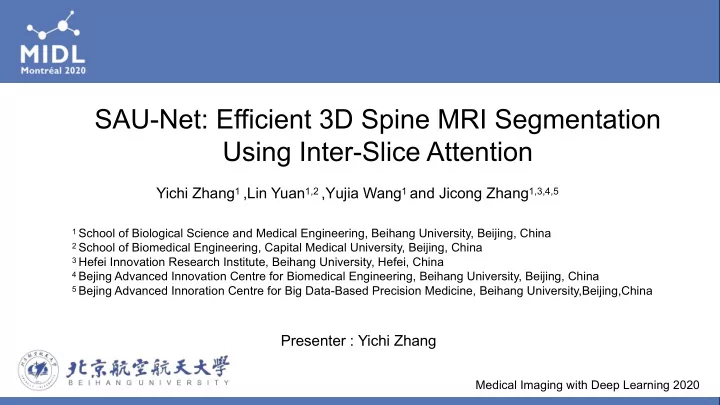

SAU-Net: Efficient 3D Spine MRI Segmentation Using Inter-Slice Attention Yichi Zhang 1 ,Lin Yuan 1,2 ,Yujia Wang 1 and Jicong Zhang 1,3,4,5 1 School of Biological Science and Medical Engineering, Beihang University, Beijing, China 2 School of Biomedical Engineering, Capital Medical University, Beijing, China 3 Hefei Innovation Research Institute, Beihang University, Hefei, China 4 Bejing Advanced Innovation Centre for Biomedical Engineering, Beihang University, Beijing, China 5 Bejing Advanced Innoration Centre for Big Data-Based Precision Medicine, Beihang University,Beijing,China Presenter : Yichi Zhang Medical Imaging with Deep Learning 2020
Introduction Accurate and robust segmentation of spine MR images is an essential tool for identification and quantitative analysis of diseased region.
Introduction Challenges: unclear boundaries abnormal spinal curvature intricacy of vertebral structures Existing spine MRI segmentation methods : 2D segmentation methods —— ignore the spatial continuity between slices 3D segmentation methods —— higher computation costs / risk of overfitting How can we utilize inter-slice information while avoiding redundant computation of 3D CNNs?
Methods SAU-Net Architecture SAU-Net (spatial attention-based densely connected U-Net)
Methods ISA Inter-slice Attention Module (ISA) Incoporating inter-slice information for refinement
Methods Inter-slice Attention Module (ISA) The structure of spatial attention fusion
Experiments Quantitative results of comparison experiments: • SAU-Net could efficiently utilize inter-slice information and outperforms 2D/3D U-Net.
Experiments Quantitative results of ablation experiments:
Conclusion • Using attention mechanism to utilize inter-slice information based on 2D segmentation networks • Improve the segmentation accuracy and efficiency, which is crucial in the clinical practice • Easily adopted to other 3D medical image segmentation tasks Thank you for your attention !
Recommend
More recommend